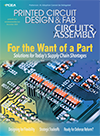Features Articles

Being ready to pivot offers flexibility and keeps vendors honest.
What is your company’s PCB buying strategy as we emerge from the confines of the Covid-19 pandemic shutdown? Do you have one?
Those responsible for corporate procurement need to understand supplier diversification is the key to remaining competitive in this challenging economy. Yet, many OEMs and EMS companies have invested too much of their annual PCB spend with only one vendor. That could prove to be a costly mistake.
I understand and appreciate vendor loyalty, but are you leveraging your vendor, or are you being leveraged by your vendor?
The truth is companies that stick with this one-vendor approach will have a harder time remaining competitive in the post-pandemic world. “We have used this vendor for years” is not a viable strategy.
To continue reading, please log in or register using the link in the upper right corner of the page.

It’s time to work with your employees toward reopening our doors to the world.
As the second half of this most extraordinary year unfolds, I keep thinking of all the things I had planned, hoped or expected to accomplish during the first half that now are on the overly long “to do” list. As we try to get back in the proverbial saddle and focus on what we can do within the confines of various local and national government pandemic restrictions and reopening timelines, my priorities are reengaging with employees, customers, suppliers and industry events.
Each industry and company has issues to work through, whether it is bringing back furloughed or terminated staff, or just figuring out whether and how to integrate work-from-home into a long-term employment scenario. In all cases, employee reentry must be dealt with quickly to rebuild the sense of corporate community and possibly build an even greater sense of team.
To continue reading, please log in or register using the link in the upper right corner of the page.

How many greenfield fabrication plants do you think have been built in the US in the past 10 years?
I can think of three, and two of them were designed and built by the same person and corporate parent. There’s Whelen Engineering, the OEM that opened a captive shop in 2015. The brains behind that, Alex Stępiński, then designed and built GreenSource Fabrication, which launched in 2018. And perhaps we can count TTM’s new plant in Chippewa Falls, built in a converted 20-year-old, 40,000-sq. ft. warehouse and officially opened last winter.
Now we can add one more to the list. More surprising, an EMS company built it.
Last month Benchmark Electronics opened the doors to its 122,000 sq. ft. state-of-the-art factory in Phoenix. The company, the fifth largest EMS in the US and 18th in the world according to the CIRCUITS ASSEMBLY Top 50, is known for putting components on boards, not making the substrates themselves. The new venture is a leap of faith, buoyed by the desire to control the product development from end to end.
To continue reading, please log in or register using the link in the upper right corner of the page.

Down the radiation rabbit hole!
Increased use of x-ray inspection throughout the component and PCBA supply chain to check the quality of optically hidden joints and features can elevate a component’s level of radiation dose during assembly. A simple and sensible question, therefore, is can this cause any issues? For example, could this increase the risk of component failure, either a complete, temporary or intermittent failure, that happens during manufacture or potentially at some later time in the field? A sensible and simple question perhaps, but, unfortunately in my experience, one that generates many further questions and uncertain answers.
In general, the industry consensus, together with the reality that x-ray inspection has been widely used for years, is that for most components there is probably not an issue with the radiation doses likely during x-ray inspection. But here we enter our rabbit hole of additional questions: What constitutes the “not most” components?
To continue reading, please log in or register using the link in the upper right corner of the page.

Are your components in balance?
Warping of flat or planar printed circuit boards is a significant yet common problem when manufacturing and assembling PCBs.
Warpage can prevent pick-and-place machines from accurately placing components. Warpage can cause the lead-free wave solder machine to pick up solder and flood the board with solder. Even worse, a warped printed circuit may not fit in the case or cause problems with automated handling equipment (buffers, etc.).
A few items cause warpage, all known and preventable. The primary reason why a PCB will warp is uneven or imbalanced copper percentages in different layers. When a design is presented to a PCB manufacturer, the fabricator will run a check of the percentage of copper on each layer. This is to ensure the design is balanced; i.e., the copper plane percentages are even about the center. Consider, for instance, a typical 8-layer PCB. A copper power plane would be on layers 4 and 5 and signal layers on the remaining layers. The innerlayer 4-5 has an almost full copper percentage on both sides. The remaining layers are low-copper-percentage signal layers. The stresses locked in by lamination will even out or equilibrate.

Is poor stencil design the culprit?
This month we illustrate solder balling and incomplete reflow when reflowing through-hole components with pin-in-paste.
Solder balling pin-in-hole reflow (PIHR) close to the body of the connector suggests poor design of the stencil for this application (FIGURE 1). There is no standoff on the corner of this part, which may have permitted the paste to be displaced when the component was attached. There should always be free space around the paste deposit to permit placement and reflow, without contacting the paste.
Press Releases
- Critical Manufacturing Partners with Canonical to Expand Cloud-Native Deployment Options for Manufacturers
- Heller Industries Becomes the Latest Partner to Join THE SMT FUTURE EXPERIENCE
- AIM Solder Signs New Distributor in Vietnam
- Variosystems launches AI platform for secure and connected supply chain services


